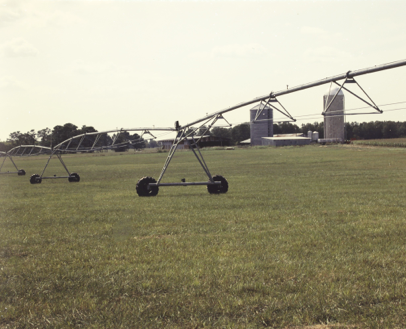
Livestock producers are aware (in fact, as a result of droughts we have had in recent years they are painfully aware) of the fact that dry weather reduces forage growth, which lowers pasture and hay forage growth. This in turn results in a need for more hay or other stored feed. Even in years of relatively good rainfall overall, there usually are periods during which pastures and hayfields become unproductive or go dormant due to lack of water. Irrigation can mitigate this situation, but this approach requires careful consideration of numerous issues. Some of these are as follows.
*Is there an inexpensive source of water available? Water sources vary greatly in cost, so this should be carefully checked. During hot weather, daily water needs by plants are generally 0.25 to 0.30 inches per day. One inch on one acre is 27,158 gallons, so the water supply must generally be able to supply 8,100 gallons per acre per day or higher to be effective for irrigating any hayfield or pasture.
*Pumping from streams may require a permit. Obviously, it is of great importance to make certain that any such requirements are met.
*The efficiency of irrigation equipment to be purchased should be considered. Newer irrigation equipment may have 85% or higher efficiency (this refers to the percent of water pumped that actually becomes available to plants), but older systems may only be around 50% efficient. Lower efficiency means more water (and more energy to pump it) is needed to get the same yield response as with higher efficiency systems.
*With irrigation, forage yields should be higher, but this means that there will likely be a need for increased fertilization. The efficiency of irrigation is reduced if forage crops are undernourished.
*In some areas, soil types, site characteristics, and/or soil compaction caused by the hooves of grazing animals may be a concern. Likewise, these factors can affect the rate of water infiltration and affect operating costs.
*Finally, will the purchase of equipment for irrigation of pastures be cost effective? The quantity and value of forage produced must be enough on average to justify installing the system, plus the expense of operating it. While application of water during a drought year may significantly increase forage production, it will be of little or no benefit during a wet year. To be cost effective, the average increase in production must be economically feasible. Irrigation equipment must be needed and used over many years to be economical.
Irrigation sounds like a good idea, and it certainly can reduce the risk of little or no pasture or hay growth. For some producers, that alone is of much value. However, irrigation is a major expenditure and should not be implemented without a lot of careful thought and calculations. While there are exceptions to most rules, in most cases it is unfortunately not economically feasible to irrigate forage crops in the Southeast.
__________________
Foraging Ahead is a column presented by Ragan & Massey and written by Dr. Don Ball, Professor Emeritus at Auburn University. Dr. Ball is one of the authors of the popular book “Southern Forages,” which can be found via a computer search that uses the words, “Southern Forages, The Fertilizer Institute.”
